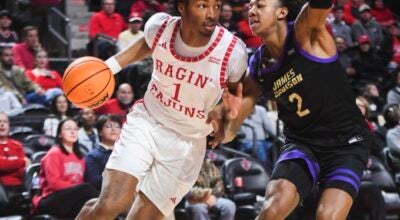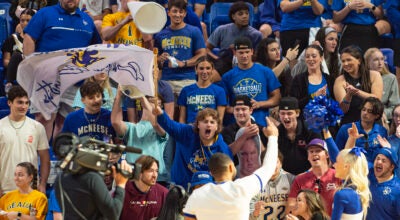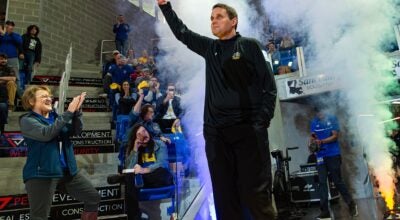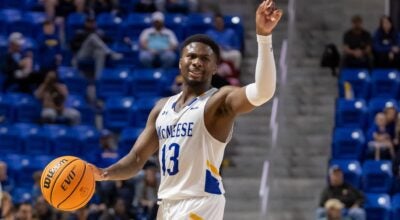New field house a labor of love
Published 7:52 am Thursday, October 16, 2014
No other building on the McNeese State University campus is as new or resplendent as the Jack V. Doland Field House, the epicenter of the athletic community.
It wasn’t always so. The building the field house replaced in 2011 was beyond an eyesore — it was unhealthy, cramped and an impediment to recruiting, to players, coaches and the public.
Dr. David Buttross III remembers. “The first year I was president of the Quarterback Club (he is currently in his second term) was 2003.
“I remember going through the field house and thinking, ‘What a ratty-a– building!” That field house was built in 1965 when McNeese had 148 student-athletes and six sports. The university today has 356 athletes in 16 sports.
“The coaches’ offices were eight by eight and they had to have players’ meetings in there. You put a couple of 300-pound men in there and they were out into the halls in a hurry.
“The showers were cesspools. We had (football) recruits, particularly those from Texas, whose high school field houses were much nicer than ours.
“We had to recruit only on a personal basis from the president (then Robert Hebert), alumni and the coaches. We would run recruits through the field house to the Cowboy Club, which was then the nicest athletic building we had,” said Buttross.
Buttross thought then the university had to have a new field house. What he didn’t know was that he was going to be the guy who got it done.
“I want to give my wife, Mia, a lot of the credit for that field house. She was pregnant with our first child when we started (2003) and had had three children before the groundbreaking (September 2009),” said Buttross.
What Buttross, a 1986 McNeese pre-med graduate and a psychiatrist, discovered was the classic academics vs. athletics battleground, not good territory for the weak of heart and an anomaly in itself.
“I didn’t do it (field house) just for the athletic department. I did it for the entire university. But our (athletic) success was not going to continue (in all sports) without a field house,” Buttross said.
The first thing he did was organize the presidents of all the booster clubs — PetroChem, Cowboy Club, Quarterback Club — and tell them his vision.
When they bought in — figuratively and later, literally — he approached the administration. But funding for an $8 million-plus building had to come from somewhere, and it was up to Buttross to figure that out.
He surrounded himself with good people. Denise Rau and Scott Doyle turned into his numbers people as co-chairs. “They are my bulldogs.
“Denise is smart and ethical; Scott was my finance chairman. Spread sheets are like comic books to him. I’m not a businessman; I’m just a doer,” said Buttross.
Gayle Zembower, an architect schooled in the vagaries of state building design, got on board. He drafted a sketch of the building-to-be that was very close to the building that is.
Zembower’s work was mostly gratis. But, Buttross said, he went way past that. “Gayle and a group of people visited LSU, TCU and asked their people, ‘What is the strength of your building, the weaknesses and what would you do if you could do it all over again.’ ”
Next, the legislative delegation stepped up. State lawmakers Vic Stelly, Ronnie Johns and Willie Mount passed bonding legislation to the tune of $4 million, a huge step and half the money.
“So we had some big money. But locally, our people were selling T-shirts for $10 and bricks for $100. That’s how we started,” said Buttross, smiling and shaking his head.
The next step was testy. Buttross and his team met with the McNeese Student Senate to get on the ballot for a proposed student assessment. “They were not receptive, and I don’t know anything about politics.
“But the (entire) coaching staff bought in, and they helped lobby the senate. We got on the ballot, and the student body passed the assessment. Jay Delafield wrote more bonding legislation, which we could pay with the student assessment.
Doyle, a 1993 McNeese graduate, said students don’t know how good they have it. “That assessment was $15 and it was permanent — 15 whole dollars. We (McNeese) are so far behind other schools, whose students pay in the hundreds for improvements that benefit them.
“Let me tell you about Tommy McClelland (then athletic director). He stuck his neck out for us; he was right there with us. He told anyone who’d listen, ‘This is a great idea; these guys know what they’re doing. The sky is not falling, we can find the money.’ ”
Buttross echoed Doyle’s comments: “We couldn’t lose our jobs — the coaches could. We could make waves, and we did.”
The expansive field house’s second floor became the Gordian knot. Buttross’ vision was of a skybox, a revenue producer with a breathtaking view of Cowboy Stadium.
“We finally met with (the late) Bob Hale, a member of the Board of Regents. He didn’t talk much, but the next day he called and said, ‘The second floor stays. Keep on doing what you’re doing,’ ” said Buttross, reliving the moment when the dream turned into reality.
The old field house was about 18,000 square feet. The new field house is 33,000 square feet with triple the air-conditioning tonnage. Only LSU has a weight room comparable to McNeese’s.
Buttross can tell you what clothes he had on for the groundbreaking. The outhouse was about to become the penthouse, and although the athletic community was parsed all over campus for the year and a half of construction, it was worth the wait.
McNeese head football coach Matt Viator rolls his eyes when he thinks about the field house campaign. “David and I talked, but after (Hurricane) Rita everyone was so engaged with their own problems, and our field house got smacked. That I didn’t expect to hear from David.
“Then the phone rings in 2004 and David said, ‘You ready?’ His tenacity was amazing. I can’t tell you how it has improved all our jobs, recruiting, coaching. He is Doctor Cowboy around here.”
As you walk into the field house, there is a plaque honoring Buttross for his work, sponsored by his parents, David and Joyce Buttross Jr.
It reads, in part, “For his work in building a Power House.” Luke 3:21 says it better: “You are my Son, the Beloved; with you I am well pleased.”





